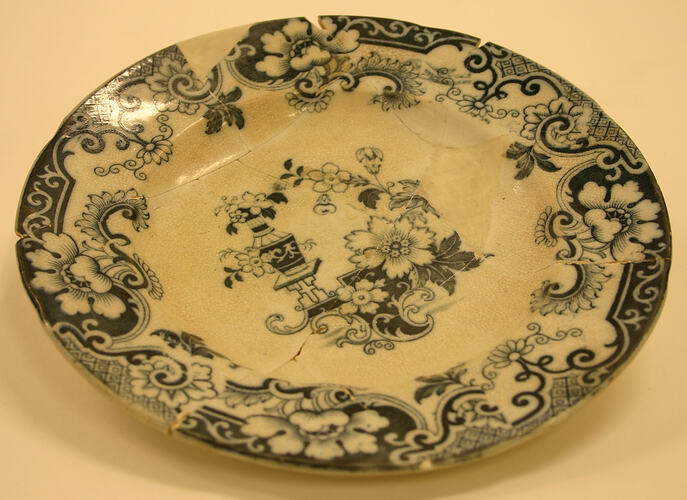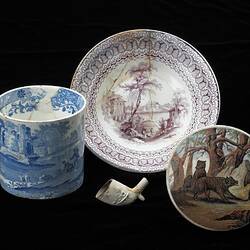Summary
This plate was reconstructed from a group of 10 fragments that were excavated at one of the digs on the Commonwealth Block between 1988 and 2003. The maker's mark calls this pattern 'Ionic', however, this pattern could not be identified in any literature. It has the manufacturer's mark 'W & B' but it is unclear who this refers to. It could be Wood & Baggaley, 1870-1880, Wood & Bowers, 1839 or Wood & Brownfield, 1838-1850, all of Staffordshire.
Numerous crockery pieces were found all over the Little Lon site. Crockery gives us a glimpse of everyday life in Melbourne in the 1880s. In the houses around Little Lon, residents used decorated crockery. Most pieces were cheap earthenware or stoneware, yet provided colour and cheer. Only a few could afford to buy matching sets, and most china was probably acquired second-hand. Some were once expensive pieces. Householders mixed and matched their crockery from the great range of mass-produced designs available. 'Blue and white' and the 'willow' pattern, was the most popular choice and was produced by English potteries from 1790.
Physical Description
This reconstructed plate is decorated with a blue and white transfer printed design. On the rim there is an abstract floral design and on the face there is a scenic floral design. Design on face shows plant in pot on a base with other flowers.
Physical Description
10 fragments of ceramic plate. Blue & white transfer printed abstract floral design on rim, scenic/ floral design on base. Manufacturers mark on base reads 'IONIC W & B'. Ionic not found in literature. Colour a grey- blue. Design on base shows plant in pot on a base with other flowers. Ionic is not found in literature, W & B could be Wood & Baggaley, 1870-1880, Wood & Bowers, 1839, Wood & Brownfield, 1838-1850, Staffordshire
More Information
-
Collection Names
-
Collecting Areas
-
Acquisition Information
Transfer from Heritage Victoria, Industry Superannuation Property Trust, 03 May 2005
-
Manufacture Name
-
Manufacturer (Possible)
Wood & Baggaley, Staffordshire, England, Great Britain, 1870-1880
-
Manufacturer (Possible)
-
Manufacturer (Possible)
Wood & Brownfield, Staffordshire, England, Great Britain, 1838-1850
-
Inscriptions
On base: 'IONIC W & B'
-
Context Number
57/13
-
Site
[TCS] Australia, Victoria, Commonwealth Block, Melbourne
-
Activity
-
Specific Activity
-
Decoration
-
Colour
Black
-
Moulding
Ionic
-
Form
Curved Marly Rim; Cylindrical Foot (Base)
-
Shape
Round, Indented
-
Technique
-
Provenance
England
-
Classification
-
Category
-
Discipline
-
Type of item
-
Exhibition Collection Management
202 mm (Width), 27 mm (Height)
Width = Diameter
-
Dimensions
2.5 cm (Height), 20 cm (Outside Diameter)
Measurement From Conservation. Measuring Method: When pieces are together
-
Keywords


